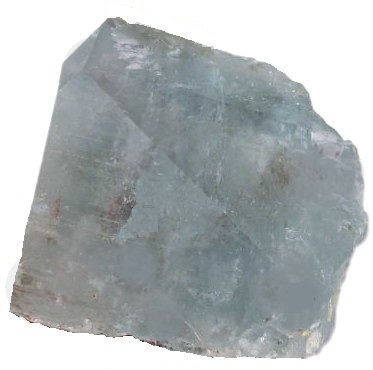
The name Topaz is believed to derive from the Greek word Topazios or Topazion, referring to an island in the Red Sea now known as Zabargad (St John’s Island), once thought to yield yellow gems later identified as peridot. Another theory suggests a link to the Sanskrit word tapas, meaning “fire,” reflecting the gem’s radiant hues. Throughout history, topaz has been known by various descriptive names such as Imperial Topaz, Precious Topaz, and Smoky Topaz—the latter, however, often misused for smoky quartz.
Composition and Physical Characteristics
Topaz is a silicate mineral composed of aluminium and fluorine, with the chemical formula Al₂SiO₄(F,OH)₂. It forms within igneous rocks, particularly granite and rhyolite, and in hydrothermal veins.
Physical characteristics include:
- Crystal System: Orthorhombic
- Hardness: 8 on the Mohs scale
- Transparency: Transparent to translucent
- Lustre: Vitreous (glassy)
- Typical Colours: Colourless, blue, yellow, orange, pink, brown, green, and the highly prized golden-orange Imperial Topaz
Varieties include:
- Imperial Topaz: Rich golden-orange to pink hues, highly valued.
- Blue Topaz: Commonly heat-treated and irradiated; includes Sky, Swiss, and London Blue varieties.
- Mystic Topaz: Coated with a thin film to create rainbow iridescence.
- Pink Topaz: Naturally rare, symbolising love and affection.
Geographical Locations
Topaz is mined worldwide, with notable deposits found in:
- Brazil: The most significant source, especially for Imperial Topaz (Minas Gerais).
- Russia: Ural Mountains, historically famed for Imperial Topaz.
- Pakistan and Afghanistan: Producing high-quality pink and golden topaz.
- Sri Lanka: Yielding fine yellow and colourless varieties.
- Nigeria and Madagascar: Known for vibrant blue and yellow stones.
- United States: Deposits in Utah and Texas.
Archaeological and Significant Finds
Topaz has adorned crowns, religious artefacts, and jewellery for millennia. Ancient Egyptians valued it as a gem of the sun god Ra, while Romans associated it with Jupiter. In medieval Europe, topaz was believed to dispel enchantments and enhance mental clarity. The 17th-century Braganza Diamond, once thought to be a massive diamond in the Portuguese crown, was later identified as a colourless topaz weighing 1,680 carats.
Historical and Current Usage
Historically, topaz symbolised divine favour, strength, and intelligence. It was worn as a talisman for protection during travel and to ward off curses. In the Victorian era, it became fashionable in brooches and cameos, particularly in its pastel shades.
Today, topaz remains a popular gemstone for rings, necklaces, and earrings due to its brilliance, affordability, and range of colours. Treated blue topaz is especially prevalent in modern jewellery, making it one of the most accessible and vibrant gems on the market.
Interesting Facts
- The largest faceted topaz, the El-Dorado Topaz from Brazil, weighs an astonishing 31,000 carats.
- Natural blue topaz is extremely rare; most blue stones are heat-treated colourless topaz.
- In folklore, topaz was believed to change colour in the presence of poison.
- It was once thought to make its wearer invisible during danger.
Folklore, Superstition, Legends, and Tales
Throughout cultures, topaz has been a symbol of light, wisdom, and protection.
- Ancient Egypt: Associated with Ra, embodying the warmth of the sun.
- Greek Mythology: Believed to increase strength and make the wearer invisible.
- Medieval Europe: Said to dispel magic spells and anger when worn as an amulet.
- Hindu Lore: Considered sacred, enhancing intelligence and longevity when worn above the heart.
Legends also claim that topaz glows in the dark and that its light could guide lost travellers.
Mystical Healing Properties
Topaz is regarded as a stone of manifestation and spiritual clarity. It encourages truth, self-realisation, and confidence.
Emotional Healing:
It aids in overcoming fear, stress, and doubt, replacing negativity with joy and abundance.
Physical Healing:
Believed to assist in improving digestion, restoring energy, and balancing metabolism. It also supports tissue regeneration and fortifies the nervous system.
Spiritual Healing:
Topaz aligns thoughts and emotions with the divine will, fostering enlightenment and serenity.
Astrology and Zodiac Links
Topaz is primarily associated with Sagittarius symbolising optimism, adventure, and truth-seeking. It resonates with Leo for confidence and vitality, and Scorpio for emotional balance and transformation.
Planetary associations include Jupiter (abundance and wisdom) and the Sun (vitality and illumination).
Chakra System Connections
Different topaz colours correspond to specific chakras:
- Blue Topaz: Throat Chakra – enhances communication and self-expression.
- Golden Topaz: Solar Plexus Chakra – strengthens confidence, willpower, and creativity.
- Pink Topaz: Heart Chakra – fosters love, compassion, and emotional healing.
- Clear Topaz: Crown Chakra – aids in spiritual clarity and divine connection.
Birthstone and Wedding Anniversary
Topaz is the birthstone for November, often shared with Citrine. It symbolises friendship, loyalty, and joy.
It is also the traditional gemstone for the 4th wedding anniversary and the Imperial Topaz marks the 23rd anniversary, representing enduring love and success.
Crystal Compatibility
Works well with:
- Citrine: Amplifies manifestation and abundance energy.
- Clear Quartz: Enhances clarity and intention-setting.
- Aquamarine: Promotes calm communication and emotional healing.
- Amethyst: Deepens spiritual awareness and balance.
Avoid pairing with:
- Obsidian or Hematite: Their grounding energy may dull topaz’s high vibrational frequency.
- Pyrite: Can create conflicting energies, particularly in manifestation rituals.
Conclusion
Topaz stands as a timeless symbol of radiance, truth, and empowerment. Whether worn for its beauty, healing energy, or historical prestige, this gemstone continues to captivate the human spirit. From its fiery origins to its celestial connections, topaz remains a beacon of light and inspiration across cultures and centuries.
